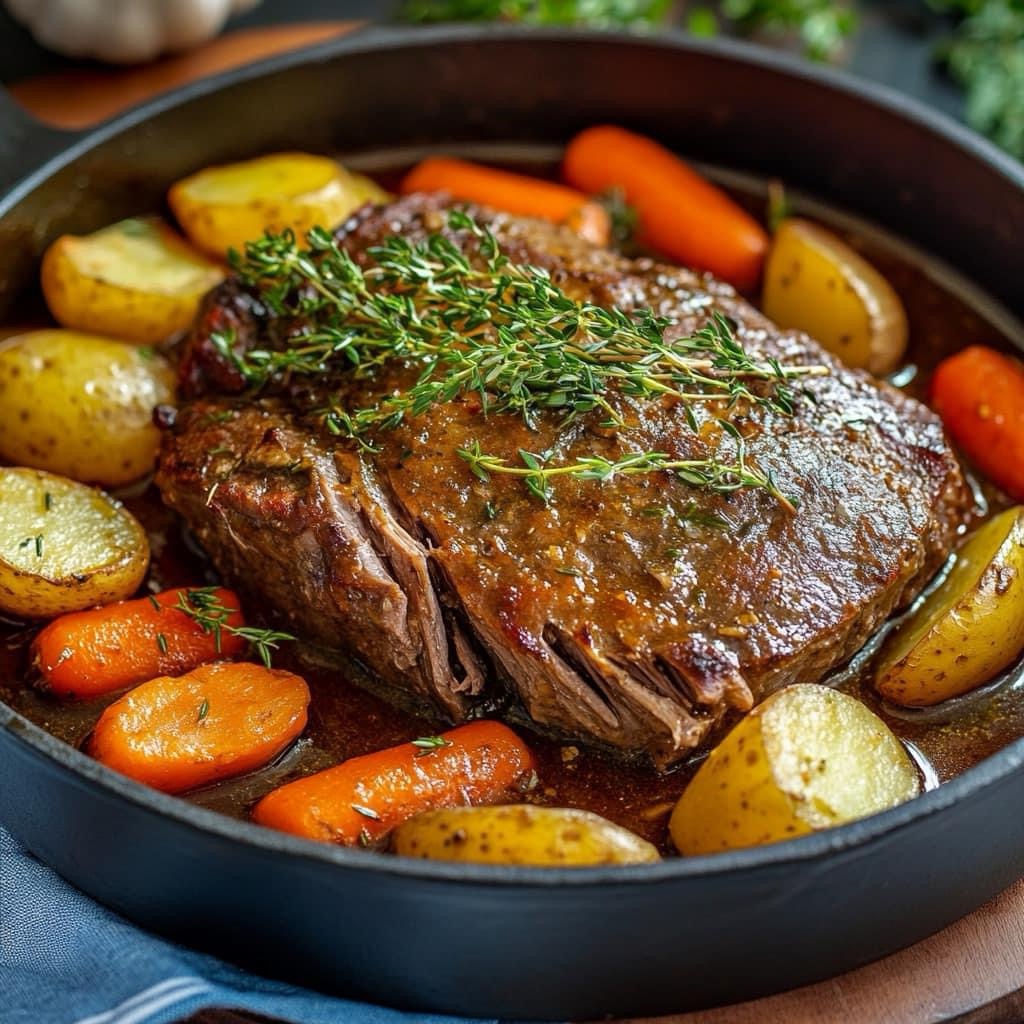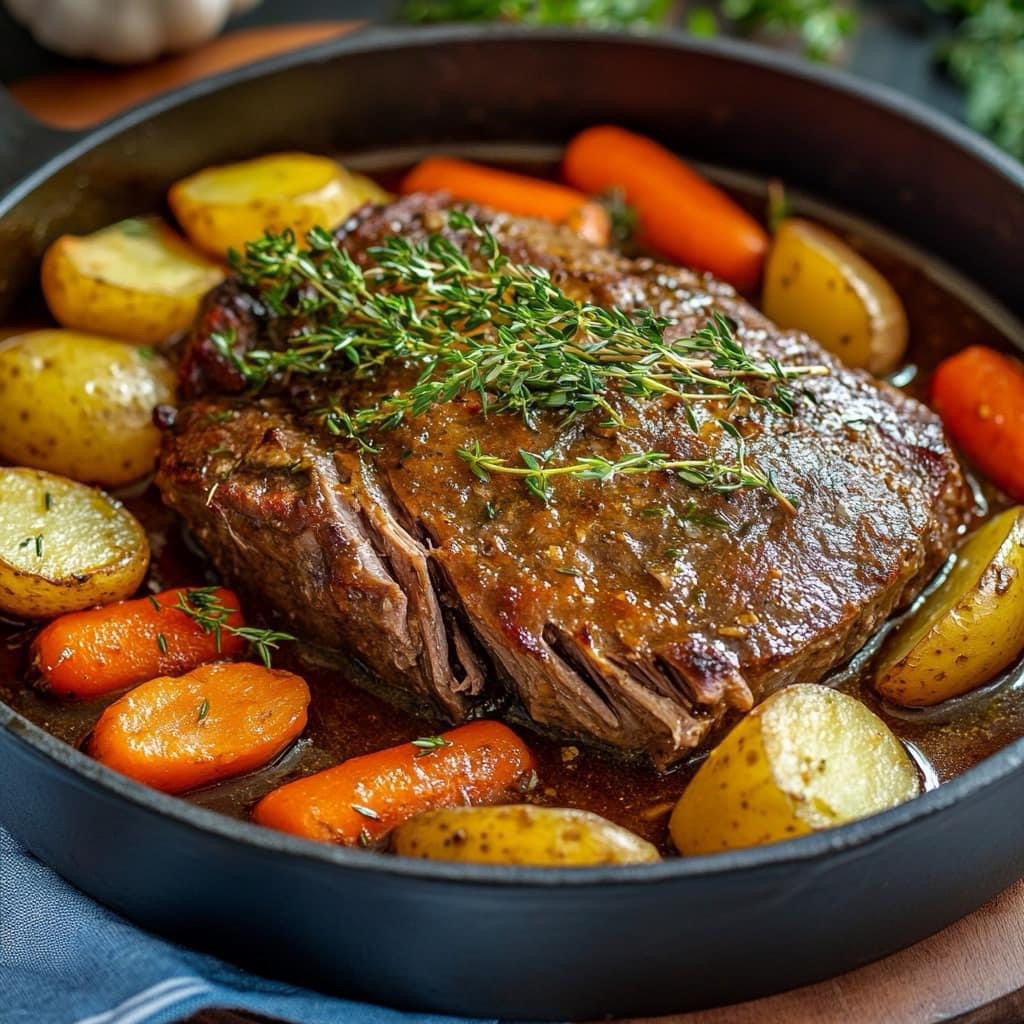
Outline
- Introduction
- Importance of Pot Roast in Comfort Food
- Why Pot Roast with Potatoes and Carrots is a Classic
- Ingredients Overview
- Preparation Steps
- Prepping the Meat
- Cutting Vegetables for Maximum Flavor
- Seasoning and Marinating Tips
- Cooking Techniques
- Oven Cooking vs. Slow Cooker: Pros and Cons
- Searing the Meat: Why It Matters
- Braising: The Secret to Tender Pot Roast
- Step-by-Step Recipe Guide
- Detailed Cooking Instructions
- Timing and Temperature Guidelines
- Making the Perfect Gravy
- Collecting Drippings for Gravy
- Thickening Agents and Methods
- Serving Suggestions
- Plating Your Pot Roast
- Pairing with Side Dishes
- Leftover Ideas
- Creative Ways to Use Pot Roast Leftovers
- Storing and Reheating Tips
- Common Mistakes to Avoid
- Overcooking vs. Undercooking
- Balancing Flavors and Seasonings
- Nutritional Information
- Caloric Content and Health Benefits
- Modifications for Health-Conscious Cooks
- History and Cultural Significance
- Origins of Pot Roast
- Variations Across Different Cultures
- Expert Tips for a Perfect Pot Roast
- Chef-Approved Techniques
- Enhancing Flavor and Texture
- FAQs
- What is the best cut of meatfor pot roast?
- Can I cook pot roast in an Instant Pot?
- How do I keep my pot roast from drying out?
- What vegetables can I substitute in this recipe?
- How can I make my pot roast more flavorful?

The Ultimate Guide to Cooking a Perfect Pot Roast with Potatoesand Carrots
Introduction
There’s something truly special about a pot roast. It’s the kind of meal that warms you from the inside out, offering comfort and satisfaction like no other. When you combine tender, slow-cooked meat with hearty potatoes and sweet carrots, you have a classic dish that’s hard to beat. Pot roast with potatoes and carrots is more than just food; it’s an experience—a nod to tradition, a celebration of simple ingredients coming together in a symphony of flavor.
Ingredients Overview
Quality of Meat Selection
The foundation of a great pot roast lies in the meat you choose. Opt for a well-marbled cut, like chuck roast, which provides the ideal balance of fat and muscle. This ensures that the meatremains tender and flavorful after hours of slow cooking.
Best Types of Potatoes and Carrots
For the potatoes, Yukon Gold is a top choice. Their buttery flavor and firm texture hold up well during the cooking process, ensuring they don’t turn mushy. When it comes to carrots, go for whole, fresh carrots instead of baby carrots. The natural sweetness and vibrant color of fresh carrots enhance the dish’s overall flavor.
Seasonings and Herbs
A good pot roast doesn’t need to be complicated with spices, but it does benefit from a few key seasonings. Salt, pepper, garlic, and onion are must-haves. Fresh herbs like thyme and rosemary add a fragrant depth, while bay leaves bring a subtle earthiness to the mix.
Preparation Steps
Prepping the Meat
Before cooking, bring your meat to room temperature. This helps it cook evenly. Pat it dry with paper towels to ensure a good sear, which is crucial for flavor. Season generously with salt and pepper.
Cutting Vegetables for Maximum Flavor
Cut your potatoes into large chunks to prevent them from breaking down too much during cooking. Carrots should be peeled and sliced into thick rounds or left whole, depending on your preference. Larger pieces of vegetables allow for a slow absorption of the flavors from the meat and broth.
Seasoning and Marinating Tips
If you have time, marinate the meat overnight in a mixture of olive oil, garlic, and herbs. This step isn’t necessary but can add extra flavor. Just be sure to pat the meat dry before searing.
Cooking Techniques
Oven Cooking vs. Slow Cooker: Pros and Cons
Oven cooking allows for even heat distribution, which can result in a beautifully browned exterior. However, a slow cooker is more convenient and ensures a consistently tender roast. Both methods are excellent, so choose the one that best fits your schedule and preference.
Searing the Meat: Why It Matters
Searing the meat before slow cooking creates a caramelized crust that adds depth to the flavor. It also helps to lock in the juices, ensuring a moist and tender final product. Use a heavy-bottomed pan and high heat for best results.
Braising: The Secret to Tender Pot Roast
Braising is the key technique in making pot roast. This method involves cooking the meat slowly in a small amount of liquid, allowing it to become tender and infused with flavor. Whether you’re using broth, wine, or a combination of both, make sure the liquid covers about half of the meat in the pot.
Step-by-Step Recipe Guide
Ingredients:
- 3-4 lbs chuck roast
- 1 lb Yukon Gold potatoes, cut into chunks
- 4 large carrots, peeled and sliced
- 1 large onion, chopped
- 4 cloves garlic, minced
- 2 cups beef broth
- 1 cup red wine (optional)
- 2 tbsp olive oil
- Salt and pepper to taste
- Fresh thyme and rosemary sprigs
- 2 bay leaves
Instructions:
- Preheat your oven to 300°F (150°C).If using a slow cooker, set it to low.
- Sear the Meat: Heat olive oil in a large, heavy-bottomed pot over medium-high heat. Sear the chuck roast on all sides until browned. Remove and set aside.
- Cook the Onions and Garlic: In the same pot, add the chopped onions and cook until softened. Add the garlic and cook for another minute.
- Deglaze the Pot: Pour in the red wine, scraping up any browned bits from the bottom of the pot. Let it simmer for a few minutes to reduce slightly.
- Add Vegetables and Meat:Place the potatoes and carrots in the pot or slow cooker. Lay the seared meat on top.
- Add Broth and Herbs: Pour in the beef broth, ensuring the liquid covers about half of the meat. Add thyme, rosemary, and bay leaves.
- Cook Low and Slow: If using an oven, cover the pot with a lid and cook for 3-4 hours. For a slow cooker, cook on low for 8 hours or until the meat is tender and pulls apart easily.
- Serve: Remove the bay leaves and herb sprigs. Slice the meat and serve with the vegetables and a generous ladle of the cooking liquid.
Making the Perfect Gravy
Collecting Drippings for Gravy
After cooking, the pot will be filled with rich, flavorful drippings. Strain these to remove any large pieces of vegetablesor herbs, leaving you with a smooth base for your gravy.
Thickening Agents and Methods
To thicken your gravy, you can use a roux (flour and butter mixture) or simply whisk in a slurry made of cornstarch and water. Simmer the gravy on the stovetop until it reaches your desired consistency.
Serving Suggestions
Plating Your Pot Roast
Serve the pot roast in a large, shallow dish with the potatoes and carrots arranged around the meat. Drizzle the gravy over the top and garnish with fresh herbs for a beautiful presentation.
Pairing with Side Dishes
Consider pairing your pot roast with a light, refreshing salad or a side of roasted vegetables. A glass of red wine or a cold beer can also complement the dish nicely.
Leftover Ideas
Creative Ways to Use Pot Roast Leftovers
Shred leftover pot roast and use it in sandwiches, tacos, or as a topping for baked potatoes. You can also repurpose it into a hearty stew by adding more vegetables and broth.
Storing and Reheating Tips
Store leftovers in an airtight container in the refrigerator for up to 3 days. Reheat gently on the stovetop or in the microwave, adding a little broth to keep the meat moist.
Common Mistakes to Avoid
Overcooking vs. Undercooking
Avoid cooking the roast at too high a temperature, as this can lead to dry meat. Conversely, make sure the meat cooks long enough to become tender. Low and slow is the key.
Balancing Flavors and Seasonings
Be careful not to over-salt the dish, especially if using pre-made broth. Taste as you go and adjust the seasoning towards the end of cooking.
Nutritional Information
Caloric Content and Health Benefits
A serving of pot roast with potatoesand carrots is not only comforting but also packed with nutrients. The dish provides a good balance of protein, carbohydrates, and essential vitamins. The beef offers a rich source of iron and B vitamins, while the potatoes and carrots supply fiber, potassium, and antioxidants.
Modifications for Health-Conscious Cooks
If you’re looking to lighten up the dish, consider using a leaner cut of meat, like a bottom round roast. You can also reduce the amount of potatoes and add more vegetables like parsnips or turnips. Skipping the wine or using a low-sodium broth can further decrease the calorie and sodium content.